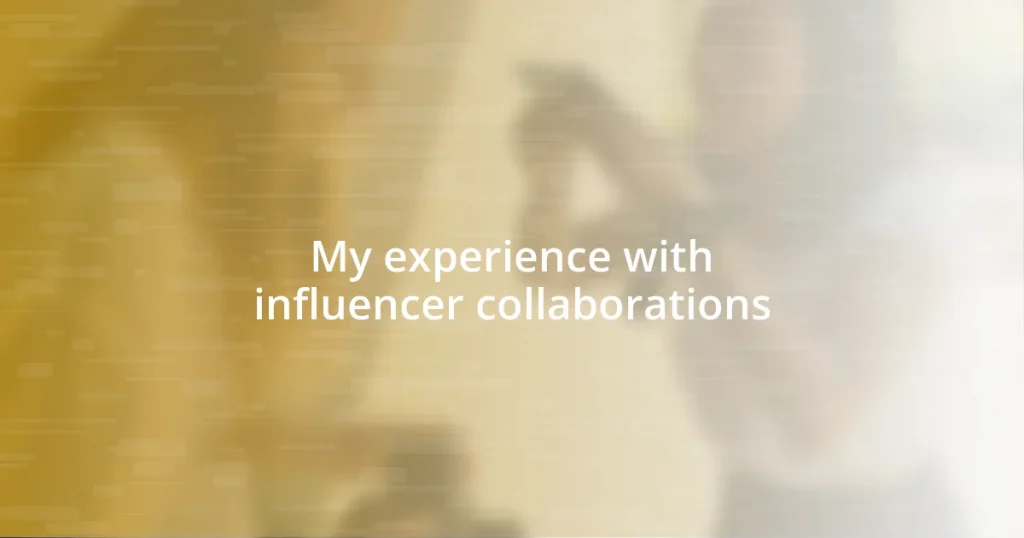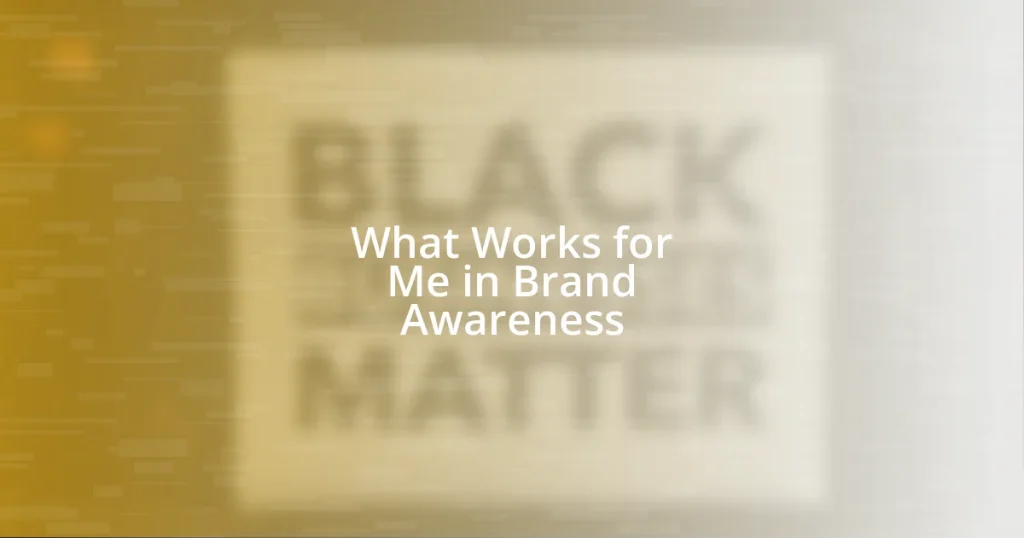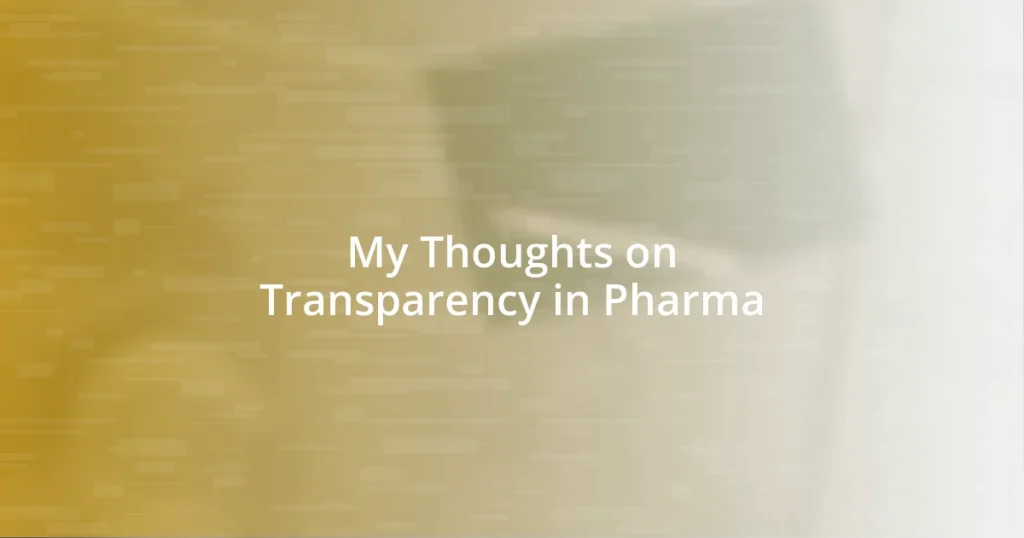Key takeaways:
- Authenticity and alignment of values are crucial for successful influencer collaborations, as they foster genuine engagement and relatability.
- Establishing clear goals and effective communication at the outset can prevent misunderstandings and ensure a focused partnership.
- Building long-term relationships through mutual support and shared experiences enhances collaboration effectiveness and loyalty.

Understanding influencer collaborations
Influencer collaborations can seem daunting at first glance, but they’re essentially partnerships that aim to leverage a creator’s audience for mutual benefit. I remember my first collaboration vividly; the excitement mixed with a bit of trepidation made it a memorable experience. Isn’t it fascinating how a single post can spark a conversation or even build a community around a shared interest?
When I began working with influencers, I quickly realized that authenticity is key. It wasn’t just about the number of followers they had; it was about how genuine their connection was with their audience. Have you ever felt drawn to a product because someone you trust recommended it? That’s the magic of influencer collaborations—they create relatable narratives that resonate deeply.
Another insight I gained was the importance of aligning values and goals. A bad match can feel forced, like trying to fit a square peg into a round hole. I’ve been there, and the disconnection was palpable. So, how do you choose the right influencer? In my experience, it comes down to shared values and genuine enthusiasm for the project, leading to authentic engagement that both parties can be proud of.

Identifying the right influencers
Identifying the right influencers is crucial for a successful collaboration. I remember a time when I partnered with an influencer who had a large following but didn’t resonate with my brand’s ethos. The posts fell flat, and I realized that numbers don’t equal engagement. Finding someone whose values align with yours can make a world of difference in how your message is received.
When searching for influencers, consider their engagement rates and the quality of their content. I once overlooked this and chose an influencer based solely on follower count. It taught me a valuable lesson: a smaller audience with high engagement can drive better results than a larger one with minimal interaction. Trust me, this first-hand experience reshaped my approach.
To aid in your search, I recommend using a comparison matrix to evaluate potential influencers systematically. This can help visualize their strengths and weaknesses, allowing for informed decisions. Below, I’ve created a simple comparison table to illustrate key factors to consider when identifying the right influencer:
| Factor | Considerations |
|---|---|
| Engagement Rate | Look beyond follower counts; focus on likes, shares, and comments. |
| Content Quality | Assess the aesthetic and messaging of their posts. |
| Brand Alignment | Ensure their values and style match your own. |
| Audience Demographics | Analyze if their audience fits your target market. |

Setting clear collaboration goals
Setting clear collaboration goals is fundamental to the success of any influencer partnership. When I launched my first collaboration, I was filled with enthusiasm but quickly realized I hadn’t outlined what I wanted to achieve. I learned the hard way that without clear objectives, it’s easy to get sidetracked or misaligned with your collaborator. Clearly defined goals set the stage for a focused and fruitful partnership.
To help you establish those goals, consider the following points:
- Brand Awareness: Are you looking to increase visibility and reach new audiences?
- Engagement: Do you want to spark conversations or boost interaction with your content?
- Sales Conversion: Is your primary aim to drive traffic and sales for a specific product or service?
- Community Building: Are you hoping to foster a sense of community or connection with your audience?
- Content Creation: Do you need fresh content that resonates with both your audience and the influencer’s followers?
By determining your objectives upfront, you pave the way for a collaboration that truly resonates, making the experience meaningful—not just for you but for your audience as well.

Establishing effective communication
Effective communication is the backbone of any successful influencer collaboration. I’ve certainly faced moments where miscommunication led to unexpected outcomes. For instance, during one collaboration, I assumed the influencer understood my brand’s voice perfectly, but their interpretation was far from what I envisioned. It was a learning moment; I realized that sharing detailed guidelines and fostering open dialogue could prevent such mix-ups.
I find that setting expectations right from the start makes a significant difference. When I began working with a new influencer, I initiated a call to discuss our vision and ideas. It created a collaborative atmosphere and made both of us feel valued. Have you ever felt that a simple conversation could bridge gaps that emails often leave? It’s true. A quick chat can clear up doubts and align both parties toward a common goal.
Remember also to check in regularly throughout the collaboration. In one project, I made the mistake of assuming everything was on track without regular updates. As a result, the campaign didn’t quite match the brand messaging we had initially agreed upon. I learned that consistent communication not only provides reassurance but also fosters a sense of teamwork that can enhance creativity and effectiveness in the campaign.

Measuring collaboration success
While setting clear goals is essential, measuring the success of your collaboration takes careful attention too. I typically rely on metrics such as engagement rate, reach, and conversion tracking. In one project, I was thrilled to see a spike in website traffic that directly corresponded with the influencer’s post. That moment reaffirmed what I suspected: tangible results deepen the collaboration’s impact and help you understand what resonates with your audience.
Another way to gauge success is through qualitative feedback. Have you ever considered that comments and messages can provide just as much insight as numbers? I recall reading through heartfelt comments after a collaboration, where followers expressed how the content resonated with their experiences. These emotional connections can reveal the true effectiveness of your messaging and guide future collaborations.
Finally, don’t overlook the importance of post-collaboration reflection. After one particularly successful partnership, I took the time to analyze what worked and what didn’t. It was an eye-opener; I noted the styles, platforms, and strategies that particularly struck a chord with the audience. This reflection is vital—it not only informs your next steps but also nurtures your growth as a collaborator. How can we improve without stepping back to evaluate our experiences? Each experience, good or bad, offers lessons for the future.

Building long-term relationships
Building long-term relationships in influencer collaborations is about nurturing connections that go beyond just a single project. I remember when I collaborated with an influencer for the first time; instead of treating it as a one-off deal, I took the initiative to get to know them. I asked about their passions and their audience, which created a bond that made our collaboration feel more authentic and impactful. Have you ever thought how showing genuine interest can turn a simple partnership into a lasting friendship?
One key lesson I’ve learned is the importance of mutual support. When my influencer partner celebrated personal milestones or launched new projects, I made it a point to share and cheer them on. This act of support paid off; it fostered a sense of loyalty that made them excited to collaborate again in the future. Isn’t it interesting how when you invest in someone else, you often see that investment returned?
Lastly, I’ve found that sharing the journey, not just the results, makes a big difference. I once had an influencer who openly discussed their creative process on social media while we were working together. Their followers loved being part of our adventure, and it deepened the relationship not only with the influencer but also with their audience. This experience taught me that involving others in your collaborative journey builds long-lasting connections. Why wouldn’t we want to share the highs and lows together?

Avoiding common collaboration pitfalls
When diving into collaborations, one common pitfall I often see is a lack of clear communication. I recall a time when I assumed my partner understood my vision without fully expressing it. The result? A project that didn’t align with my brand, leading to disappointment on both sides. Have you ever left things unsaid, thinking they’re understood? It’s crucial to lay everything out—from expectations to deliverables—ensuring that everyone’s on the same page.
Another mistake I’ve encountered is not doing enough research on the influencer before collaborating. There was an instance where I jumped into a partnership without fully checking their audience engagement. It turned out they had a significant number of followers but very low interaction rates. This experience underscored the importance of vetting potential collaborators thoroughly. By asking yourself, “Do their values align with mine?” you can avoid mismatches that may hinder the effectiveness of the campaign.
Lastly, I’ve learned the hard way that not setting boundaries can lead to awkward situations later. In one collaboration, I found myself answering messages at all hours, which blurred the lines of professionalism. This lack of boundaries created stress rather than synergy. Have you ever felt overwhelmed by unclear limits? Establishing these boundaries upfront can help maintain a healthy working relationship, ensuring that both parties feel respected and valued throughout the collaboration process.















